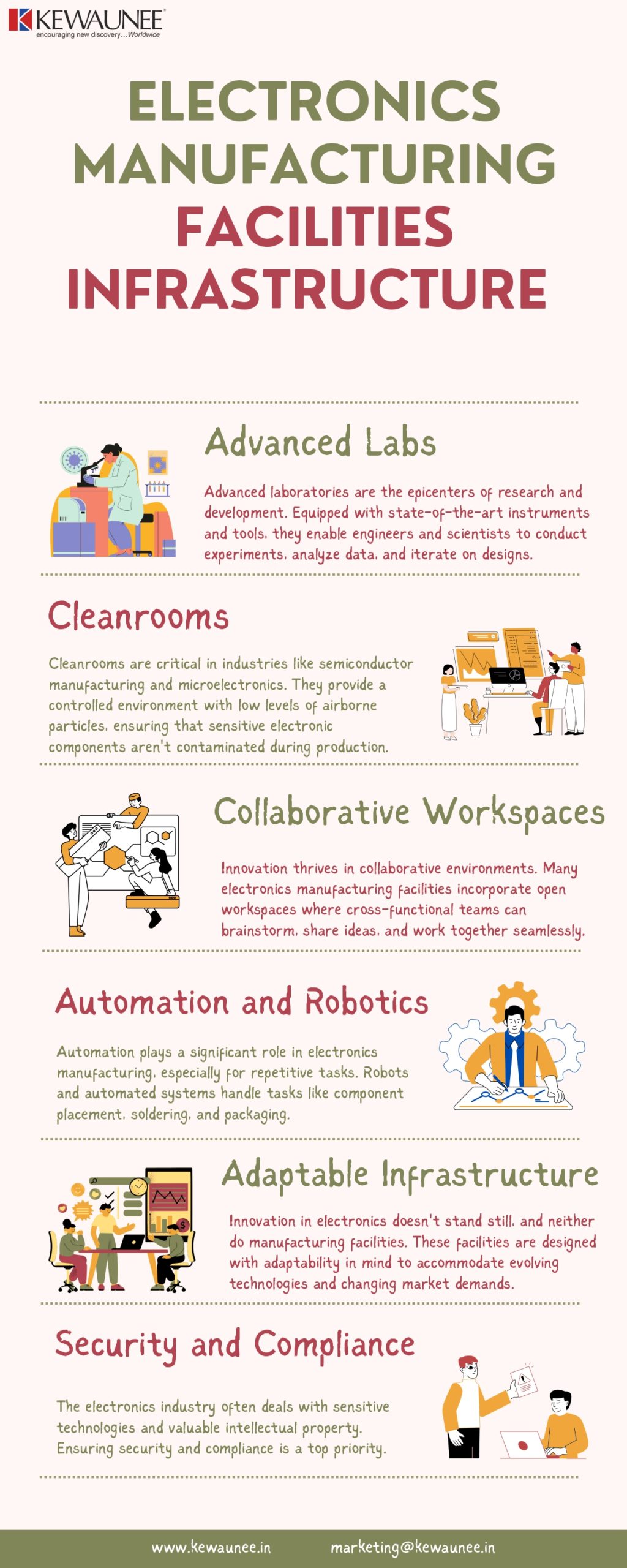Electronics Manufacturing Facilities Infrastructure
In the rapidly evolving landscape of electronics manufacturing, the facilities where innovation takes shape play a pivotal role. These facilities are more than just physical spaces; they are the birthplaces of technological advancements, the heart of product development, and the nerve center of precision engineering.
In this blog, we’ll delve into the world of electronics manufacturing facilities, exploring their infrastructure, importance, and the dynamic role they play in driving innovation.
1. The Foundation of Innovation
At the core of every electronics manufacturing facility lies the foundation of innovation. These facilities are purposefully designed and equipped to foster creativity and problem-solving. They are where ideas come to life, where engineers and technicians transform concepts into tangible products.
The essential elements that form the foundation of innovation within electronics manufacturing facilities:
a) Advanced Laboratories
Advanced laboratories are the epicenters of research and development. Equipped with state-of-the-art instruments and tools, they enable engineers and scientists to conduct experiments, analyze data, and iterate on designs. From materials testing to circuit prototyping, laboratories are where innovation begins.
b) Cleanrooms
Cleanrooms are critical in industries like semiconductor manufacturing and microelectronics. They provide a controlled environment with low levels of airborne particles, ensuring that sensitive electronic components aren’t contaminated during production. Cleanrooms are essential for achieving high yields and product reliability.
c) Collaborative Workspaces
Innovation thrives in collaborative environments. Many electronics manufacturing facilities incorporate open workspaces where cross-functional teams can brainstorm, share ideas, and work together seamlessly. These spaces encourage interdisciplinary collaboration and knowledge sharing.
2. Precision Manufacturing
Electronics manufacturing is synonymous with precision. The ability to create intricate circuits, assemble microcomponents, and ensure the reliability of electronic devices requires advanced manufacturing capabilities.
a) Surface Mount Technology (SMT)
SMT is a cornerstone of modern electronics assembly. It involves placing electronic components directly onto the surface of a printed circuit board (PCB). Electronics manufacturing facilities are equipped with high-speed SMT machines that can place thousands of components per hour with exceptional accuracy.
b) Quality Control
Quality control is paramount in electronics manufacturing. Facilities invest in advanced inspection and testing equipment to ensure that every component and product meets stringent quality standards. Automated optical inspection (AOI) and X-ray inspection are commonly used to identify defects and ensure product reliability.
c) Automation and Robotics
Automation plays a significant role in electronics manufacturing, especially for repetitive tasks. Robots and automated systems handle tasks like component placement, soldering, and packaging. These technologies enhance efficiency and precision while reducing the risk of human error.
3. Adaptable Infrastructure
Innovation in electronics doesn’t stand still, and neither do manufacturing facilities. These facilities are designed with adaptability in mind to accommodate evolving technologies and changing market demands.
a) Modular Design
Modular design allows for the easy reconfiguration of production lines and workspaces. This flexibility is essential when transitioning to new product designs or scaling up production to meet increased demand.
b) Scalable Cleanrooms
Cleanrooms can be expanded or downsized as needed, providing the flexibility to adjust production capacity. This scalability is crucial for accommodating changes in production volume without compromising product quality.
c) Sustainable Practices
Many electronics manufacturing facilities incorporate sustainable practices into their infrastructure. From energy-efficient lighting to waste reduction initiatives, these facilities are committed to reducing their environmental footprint while maintaining high-quality production.
4. Security and Compliance
The electronics industry often deals with sensitive technologies and valuable intellectual property. Ensuring security and compliance is a top priority.
a) Intellectual Property Protection
Facilities implement strict protocols to safeguard intellectual property. Access control, data encryption, and employee training are among the measures taken to protect sensitive information.
b) Regulatory Compliance
Compliance with industry-specific regulations, such as RoHS (Restriction of Hazardous Substances) and ISO standards, is non-negotiable. Facilities undergo regular audits to ensure adherence to these standards.
c) Supply Chain Resilience
Electronics manufacturing facilities maintain resilient supply chains to mitigate disruptions. This involves dual sourcing of critical components and maintaining strategic inventories.
Summary
Electronics manufacturing facilities are the engine rooms of innovation, where ideas are transformed into cutting-edge technologies. They are designed to foster creativity, facilitate precision manufacturing, adapt to changing needs, and ensure security and compliance.
As the electronics industry continues to evolve, these facilities will remain at the forefront, driving progress and innovation that shapes our digital future.
Comments are closed.











